Identification and Forecast of Potential Fishing Grounds for Anchovy (Engraulis ringens) in Northern Chile Using Neural Networks Modeling
Abstract
:1. Introduction
2. Materials and Methods
2.1. Fishery and Environmental Data
2.2. A forecasting Model Based on Artificial Neural Network
2.3. Model Validation
2.4. Model Application
3. Results
3.1. Performance of the Artificial Neural Network Forecasting Model
3.2. Model Application
4. Discussion
Author Contributions
Funding
Data Availability Statement
Acknowledgments
Conflicts of Interest
References
- Barros, M.E.; Neira, S.; Arancibia, H. Trophic interactions in northern Chile upwelling ecosystem, Year 1997. Lat. Am. J. Aquat. Res. 2014, 42, 1109–1125. [Google Scholar] [CrossRef]
- Medina, M.; Arancibia, H.; Neira, S. Un modelo trófico preliminar del ecosistema pelágico del norte de Chile (18°20′ S–24°00′ S). Invest. Mar. 2007, 35, 25–38. [Google Scholar] [CrossRef]
- Espíndola, F.; Quiroz, J.C.; Böhm, G.; Leiva, F.; Aros, J.A. INFORME 2 ESTATUS. Convenio de Desempeño 2017. Estatus y posibilidades de explotación biológicamente sustentables de los principales recursos pesqueros nacionales Año 2018: Anchoveta XV-II Regiones. Inst. Fom. Pesque 2018. [Google Scholar] [CrossRef]
- Silva, C.; Andrade, I.; Yáñez, E.; Hormazabal, S.; Barbieri, M.A.; Aranis, A.; Böhm, G. Predicting habitat suitability and geographic distribution of anchovy (Engraulis ringens) due to climate change in the coastal areas off Chile. Prog. Oceanogr. 2016, 146, 159–174. [Google Scholar] [CrossRef]
- Böhm, M.G.; Hernández, C.; Días, E.; Pérez, G.; Ojeda, R.; Cerna, F.; Valero, C.; Gómez, M.; Machuca, C.; Muñoz, L. INFORME FINAL. Convenio de Desempeño, 2016. Programa de seguimiento de las principales pesquerías pelágicas de la zona norte de Chile, XV–IV Regiones, Año 2016. Inst. Fom. Pesq. 2017. [Google Scholar]
- Dec. Ex. N° 22-2022 Modifica Dec. Ex. Folio 202100228 Establece Cuota de Captura de Unidades de Pesquería de Anchoveta y Sardina Española Zona Norte Sometidas a Licencias Transables de Pesca, Año 2022. (Publicado En Página Web 23-05-2022) (F.D.O. 25-05-2022)–SUBPESCA Normativa. Available online: https://www.subpesca.cl/portal/615/w3-article-114576.html (accessed on 27 June 2022).
- Memoria Corpesca. 2021. Available online: https://www.corpesca.cl/wp-content/uploads/2022/04/Memoria-Anual-Corpesca-2021.pdf (accessed on 27 June 2022).
- Memoria Camanchaca. 2021. Available online: https://www.camanchaca.cl/wp-content/uploads/2022/04/Camanchaca-Memoria-2021-web.pdf (accessed on 27 June 2022).
- NOAA Climate Prediction Center. Available online: https://origin.cpc.ncep.noaa.gov/products/analysis_monitoring/ensostuff/ONI_v5.php (accessed on 29 October 2020).
- Ley N° 19.713 Establece Como Medida de Administración el Límite Máximo de Captura por Armador a las Principales Pesquerías Industriales Nacionales y la Regularización del Registro Pesquero Artesanal; Subsecretaría de Pesca; Ministerio de Economía, Fomento y Reconstrucción: Santiago, Chile, 2001.
- Ley N° 19.822 Modifica la ley Nº 19.713, Incorporando las Unidades de Pesquería que Indica en las Zonas que Señala la Medida de Administración Límite Máximo de Captura por Armador; Subsecretaría de Pesca; Ministerio de Economía, Fomento y Reconstrucción: Santiago, Chile, 2002.
- Nammalwar, P.; Satheesh, S.; Ramesh, R. Applications of remote sensing in the validations of potential fishing zones (PFZ) along the Coast of North Tamil Nadu, India. Indian J. Mar. Sci. 2013, 42, 283–292. [Google Scholar]
- Wang, J.; Yu, W.; Chen, X.; Lei, L.; Chen, Y. Detection of potential fishing zones for neon flying squid based on remote-sensing data in the northwest Pacific Ocean using an artificial neural network. Int. J. Remote Sens. 2015, 36, 3317–3330. [Google Scholar] [CrossRef]
- Suryanarayana, I.; Braibanti, A.; Sambasiva Rao, R.; Ramam, V.A.; Sudarsan, D.; Nageswara Rao, G. Neural networks in fisheries research. Fish. Res. 2008, 92, 115–139. [Google Scholar] [CrossRef]
- Yáñez, E.; Plaza, F.; Gutiérrez-Estrada, J.C.; Rodríguez, N.; Barbieri, M.A.; Pulido-Calvo, I.; Bórquez, C. Anchovy (Engraulis ringens) and sardine (Sardinops sagax) abundance forecast off northern Chile: A multivariate ecosystemic neural network approach. Prog. Oceanogr. 2010, 87, 242–250. [Google Scholar] [CrossRef]
- Home | CMEMS. Available online: https://marine.copernicus.eu/ (accessed on 22 March 2022).
- Data | Copernicus Marine. Available online: https://resources.marine.copernicus.eu/product-detail/GLOBAL_ANALYSIS_FORECAST_PHY_001_024/INFORMATION (accessed on 22 March 2022).
- Legaloudec, O.; Desportes, C.; Levier, B. Quality information document for global sea physical analysis and forecasting product. Mercator Ocean. Q. Newsl. 2019, 1–100. [Google Scholar]
- Madec, G.; Bourdallé-Badie, R.; Bouttier, P.-A.; Bricaud, C.; Bruciaferri, D.; Calvert, D.; Chanut, J.; Clementi, E.; Coward, A.; Delrosso, D.; et al. NEMO Ocean Engine. 2017. Available online: https://zenodo.org/record/3248739#.Ys-BY4RBxPY (accessed on 27 June 2022).
- TensorFlow. Available online: https://www.tensorflow.org/ (accessed on 27 June 2022).
- Moolayil, J.; Moolayil, J.; John, S. Learn Keras for Deep Neural Networks; Springer: Berlin/Heidelberg, Germany, 2019. [Google Scholar]
- Bertrand, S.; Díaz, E.; Lengaigne, M. Patterns in the spatial distribution of peruvian anchovy (Engraulis ringens) revealed by spatially explicit fishing data. Prog. Oceanogr. 2008, 79, 379–389. [Google Scholar] [CrossRef]
- Sklearn.Preprocessing.StandardScaler–Scikit-Learn 1.1.1 Documentation. Available online: https://scikit-learn.org/stable/modules/generated/sklearn.preprocessing.StandardScaler.html (accessed on 27 June 2022).
- Jin, H.; Song, Q.; Hu, X. Auto-Keras: An Efficient Neural Architecture Search System. In Proceedings of the 25th ACM SIGKDD International Conference on Knowledge Discovery & Data Mining; Association for Computing Machinery: New York, NY, USA, 2019; pp. 1946–1956. [Google Scholar]
- Sharma, S.; Sharma, S.; Athaiya, A. Activation Functions in Neural Networks. Int. J. Eng. Appl. Sci. Technol. 2020, 4, 310–316. [Google Scholar] [CrossRef]
- Kingma, D.P.; Ba, J.L. Adam: A method for stochastic optimization. In Proceedings of the 3rd International Conference on Learning Representations, ICLR 2015, San Diego, CA, USA, 7–9 May 2015; pp. 1–15. [Google Scholar]
- ReduceLROnPlateau. Available online: https://keras.io/api/callbacks/reduce_lr_on_plateau/ (accessed on 27 June 2022).
- EarlyStopping. Available online: https://keras.io/api/callbacks/early_stopping/ (accessed on 27 June 2022).
- de Sá, C.R. Variance-based feature importance in neural networks. Lect. Notes Comput. Sci. 2019, 11828, 306–315. [Google Scholar] [CrossRef]
- Verma, S.; Rubin, J. Fairness Definitions Explained. Proc.–Int. Conf. Softw. Eng. 2018, 24, 1–7. [Google Scholar] [CrossRef]
- Wardhani, N.W.S.; Rochayani, M.Y.; Iriany, A.; Sulistyono, A.D.; Lestantyo, P. Cross-validation metrics for evaluating classification performance on imbalanced data. In Proceedings of the 2019 International Conference on Computer, Control, Informatics and Its Applications, Tangerang, Indonesia, 23–24 October 2019; pp. 14–18. [Google Scholar] [CrossRef]
- Hoo, Z.H.; Candlish, J.; Teare, D. What is an ROC curve? Emerg. Med. J. 2017, 34, 357–359. [Google Scholar] [CrossRef] [PubMed]
- Maina, I.; Kavadas, S.; Katsanevakis, S.; Somarakis, S.; Tserpes, G.; Georgakarakos, S. A methodological approach to identify fishing grounds: A case study on greek trawlers. Fish. Res. 2016, 183, 326–339. [Google Scholar] [CrossRef]
- Mateo, R.G.; Felicísimo, Á.M.; Muñoz, J. Modelos de distribución de especies: Una revisión sintética. Rev. Chil. Hist. Nat. 2011, 84, 217–240. [Google Scholar] [CrossRef]
- Zhang, X.; Saitoh, S.I.; Hirawake, T. Predicting potential fishing zones of japanese common squid (Todarodes pacificus) using remotely sensed images in coastal waters of South-Western Hokkaido, Japan. Int. J. Remote Sens. 2017, 38, 6129–6146. [Google Scholar] [CrossRef]
- Barbieri, M.A.B.; Yanez, E.R.; Farias, M.S.; Aguilera, R.H. Determination of probable fishing areas for the albacore (Thunnus Alalunga) in Chile’s central zone. Dig. Int. Geosci. Remote Sens. Symp. 1989, 4, 2447–2450. [Google Scholar] [CrossRef]
- Nieto, K.; Yánez, E.; Silva, C.; Barbieri, M.A. Probable fishing grounds for anchovy in northern Chile using an expert system. Int. Geosci. Remote Sens. Symp. 2001, 7, 2985–2987. [Google Scholar] [CrossRef]
- Silva, C.; Nieto, K.; Barbieri, M.A.; Yáñez, E. Expert systems for fishing ground prediction models: A management tool in the Humboldt ecosystem affected by ENSO. Investig. Mar. 2002, 30, 201–204. [Google Scholar] [CrossRef]
- Yáñez, E.; Silva, C.; Nieto, K.; Barbieri, M.A.; Martínez, G. Using satellite technology improve chilean purseine fishing fleet. Gayana 2004, 68, 578–585. [Google Scholar] [CrossRef]
- Silva, C.; Barbieri, M.A.; Yáñez, E.; Gutiérrez-Estrada, J.C.; Delvalls, Á. Using indicators and models for an ecosystem approach to fisheries and aquaculture management: The anchovy fishery and pacific oyster culture in Chile: Case studies. J. Aquat. Res 2012, 40, 955–969. [Google Scholar] [CrossRef]
- Ren-Yan, D.; Xiao-Quan, K.; Min-Yi, H.; Wei-Yi, F.; Zhi-Gao, W. The predictive performance and stability of six species distribution models. PLoS ONE 2014, 9, e112764. [Google Scholar] [CrossRef]
- Yusop, S.M.; Mustapha, M.A. Influence of oceanographic parameters on the seasonal potential fishing grounds of Rastrelliger kanagurta using maximum entropy models and remotely sensed data. Sains Malays. 2019, 48, 259–269. [Google Scholar] [CrossRef]
- Joy, M.K.; Death, R.G. Predictive modelling and spatial mapping of freshwater fish and decapod assemblages using GIS and neural networks. Freshw. Biol. 2004, 49, 1036–1052. [Google Scholar] [CrossRef]
- Tan, C.O.; Beklioglu, M. Modeling complex nonlinear responses of shallow lakes to fish and hydrology using artificial neural networks. Ecol. Modell. 2006, 196, 183–194. [Google Scholar] [CrossRef]
- Yudaputra, A.; Robiansyah, I.; Rinandio, D.S. The Implementation of Artificial Neural Network and Random Forest in Ecological Research: Species Distribution Modelling with Presence and Absence Dataset. In Proceedings of the 3rd SATREPS Conference, 2019. Available online: https://publikasikr.lipi.go.id/index.php/satreps/article/view/216 (accessed on 27 June 2022).
- Melo-Merino, S.M.; Reyes-Bonilla, H.; Lira-Noriega, A. Ecological niche models and species distribution models in marine environments: A literature review and spatial analysis of evidence. Ecol. Modell. 2020, 415, 108837. [Google Scholar] [CrossRef]
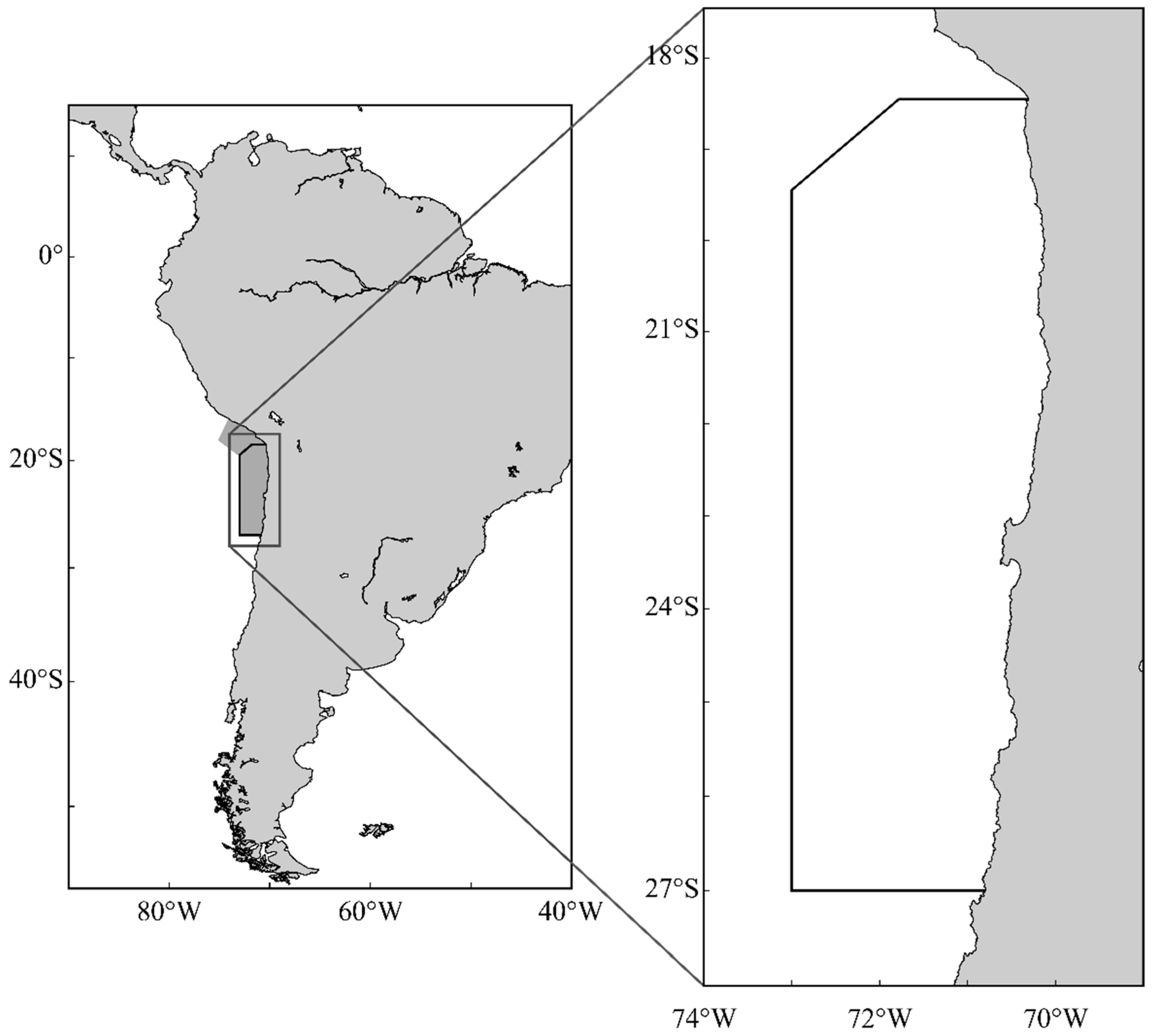
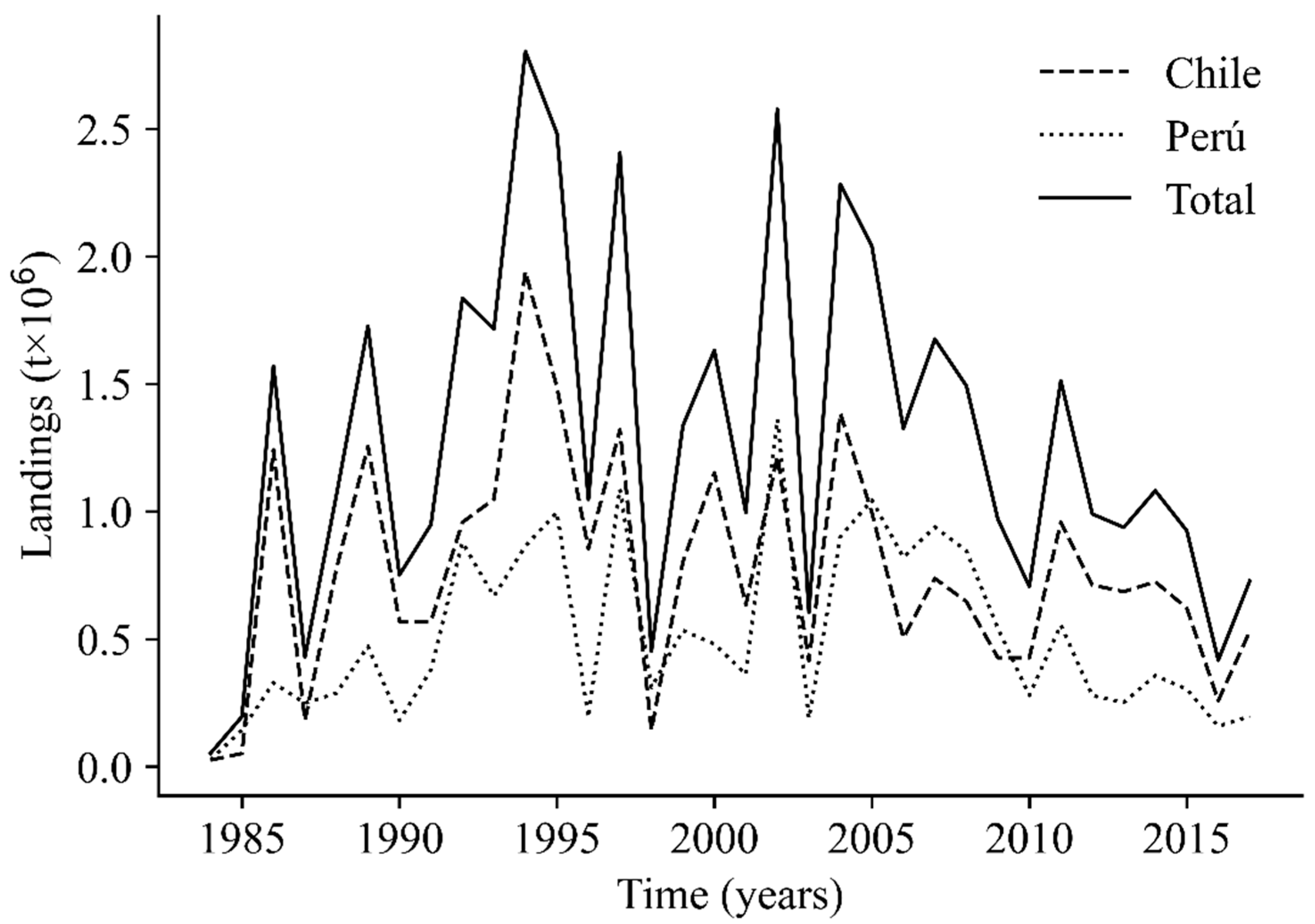
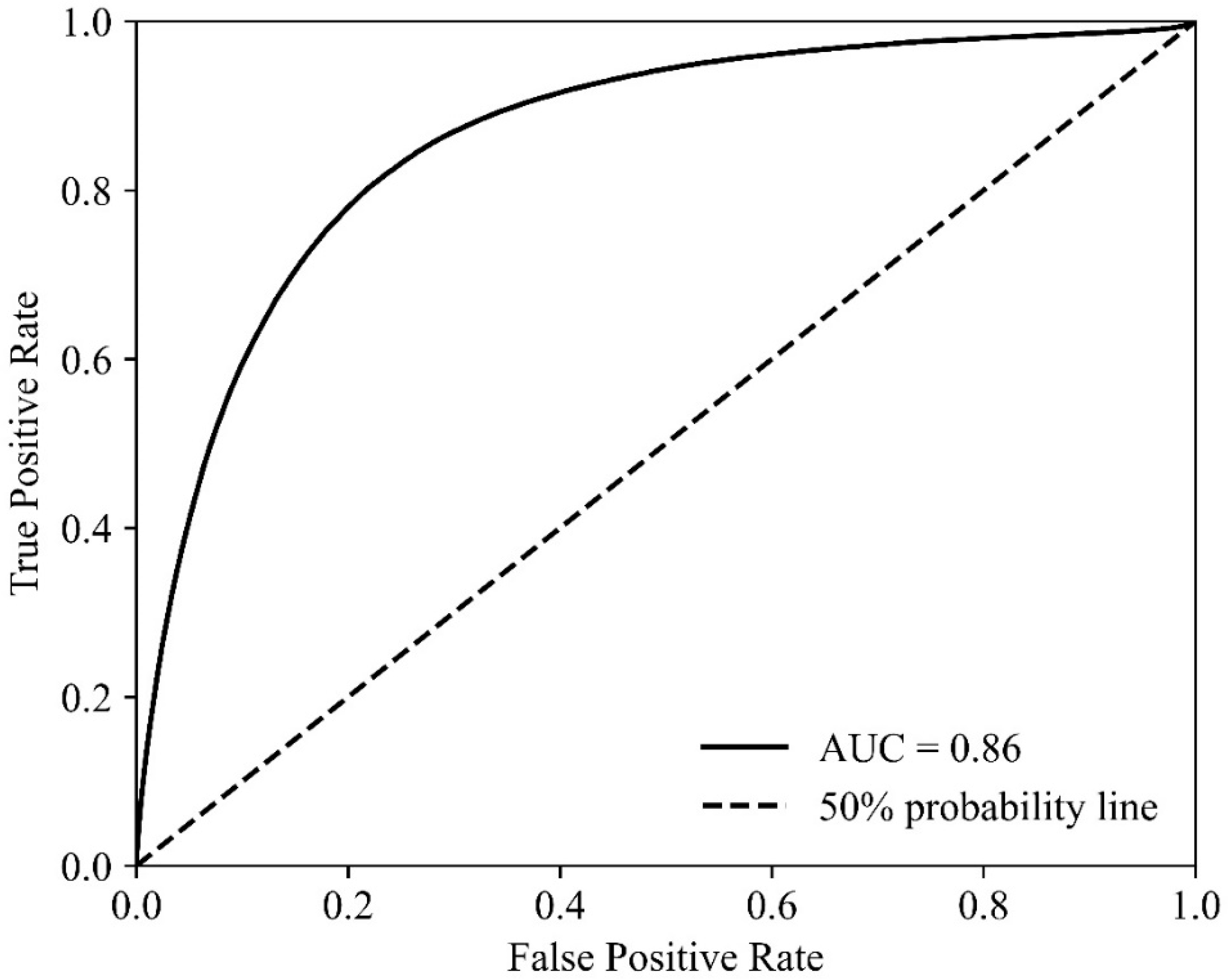
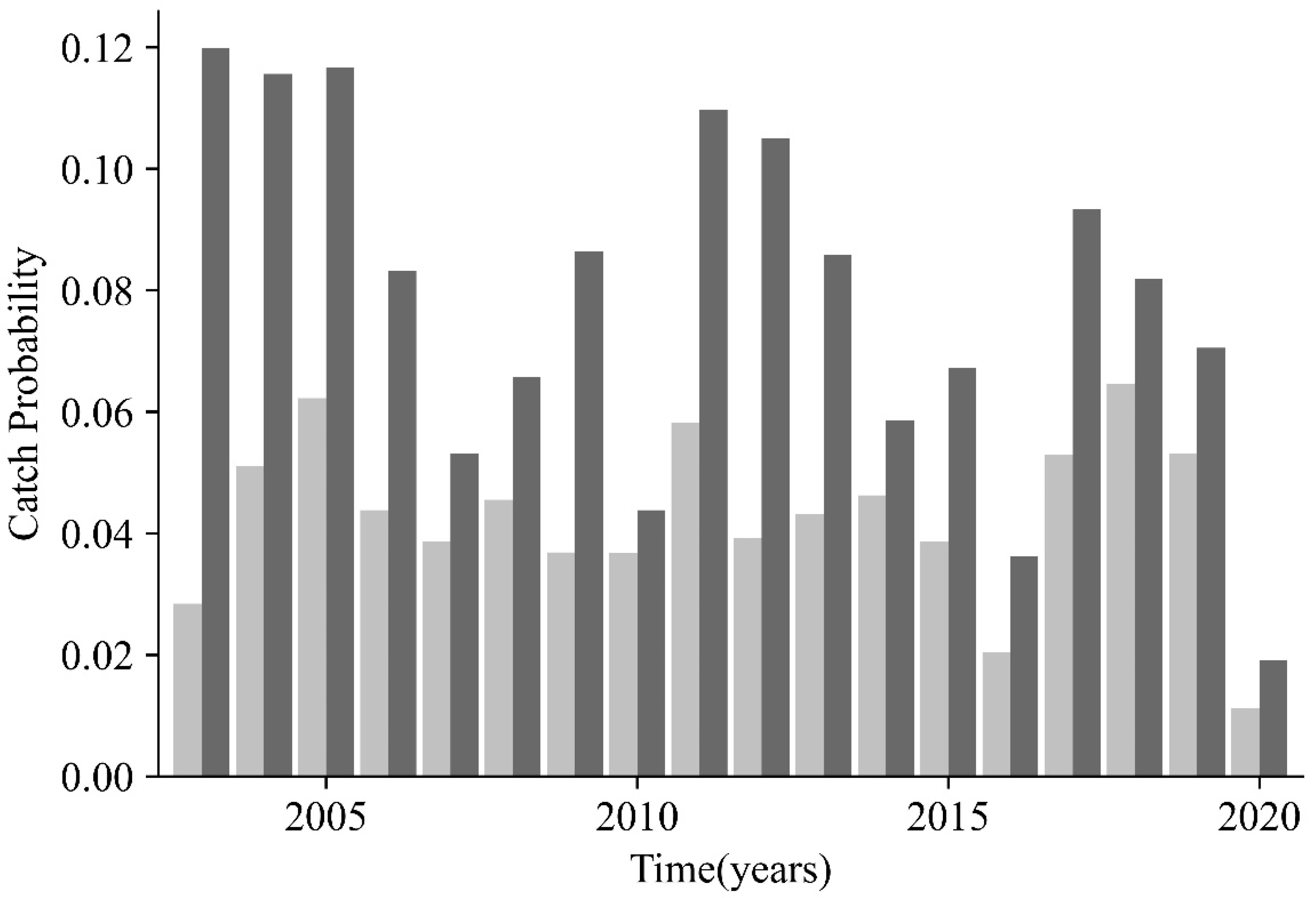
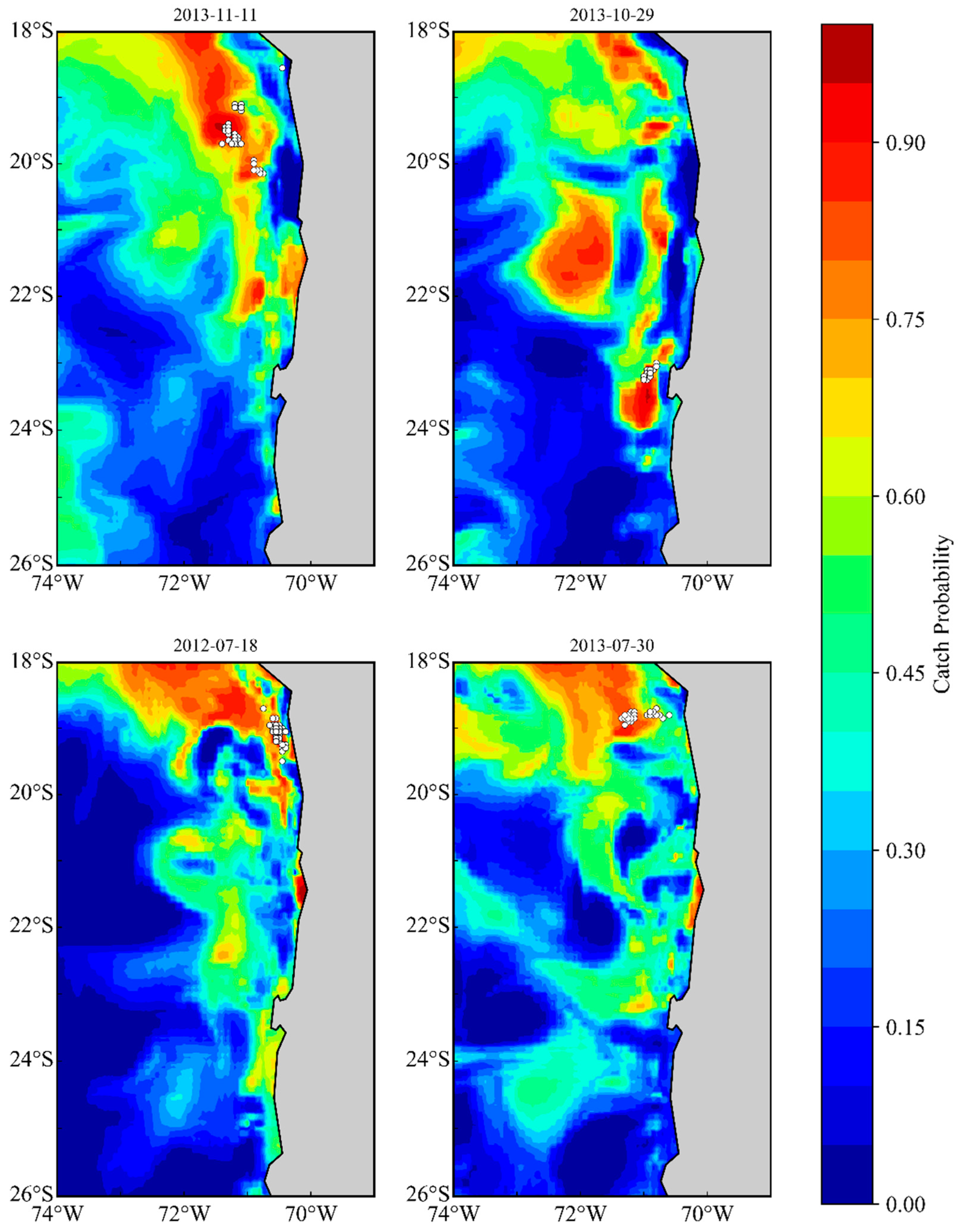
| Non-Potential Fishing Grounds | Potential Fishing Grounds | Total | |
|---|---|---|---|
| Areas visited | 216,841 | 85,341 | 302,182 |
| Capture areas | 2853 | 10,606 | 13,459 |
| Probability | 0.013 | 0.124 | 0.045 |
| n | Mean | Standard Deviation | Minimun Value | 25% | 50% | 75% | Maximum Value | |
|---|---|---|---|---|---|---|---|---|
| Precision | 36 | 0.208 | 0.136 | 0.063 | 0.121 | 0.174 | 0.242 | 0.654 |
| False omission rate (FOR) | 36 | 0.036 | 0.028 | 0.004 | 0.012 | 0.026 | 0.054 | 0.11 |
| Recall | 36 | 0.764 | 0.211 | 0.125 | 0.705 | 0.844 | 0.911 | 0.971 |
Publisher’s Note: MDPI stays neutral with regard to jurisdictional claims in published maps and institutional affiliations. |
© 2022 by the authors. Licensee MDPI, Basel, Switzerland. This article is an open access article distributed under the terms and conditions of the Creative Commons Attribution (CC BY) license (https://creativecommons.org/licenses/by/4.0/).
Share and Cite
Armas, E.; Arancibia, H.; Neira, S. Identification and Forecast of Potential Fishing Grounds for Anchovy (Engraulis ringens) in Northern Chile Using Neural Networks Modeling. Fishes 2022, 7, 204. https://doi.org/10.3390/fishes7040204
Armas E, Arancibia H, Neira S. Identification and Forecast of Potential Fishing Grounds for Anchovy (Engraulis ringens) in Northern Chile Using Neural Networks Modeling. Fishes. 2022; 7(4):204. https://doi.org/10.3390/fishes7040204
Chicago/Turabian StyleArmas, Elier, Hugo Arancibia, and Sergio Neira. 2022. "Identification and Forecast of Potential Fishing Grounds for Anchovy (Engraulis ringens) in Northern Chile Using Neural Networks Modeling" Fishes 7, no. 4: 204. https://doi.org/10.3390/fishes7040204
APA StyleArmas, E., Arancibia, H., & Neira, S. (2022). Identification and Forecast of Potential Fishing Grounds for Anchovy (Engraulis ringens) in Northern Chile Using Neural Networks Modeling. Fishes, 7(4), 204. https://doi.org/10.3390/fishes7040204





